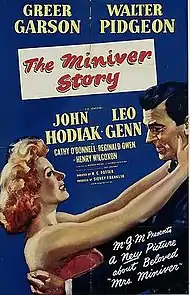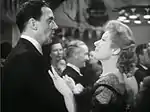The Miniver Story
The Miniver Story is a 1950 American drama film that is the sequel to the 1942 film Mrs. Miniver. Like its predecessor, the picture was made by MGM stars Greer Garson and Walter Pidgeon, but it was filmed on-location in England. The film was directed by H.C. Potter and produced by Sidney Franklin, from a screenplay by George Froeschel and Ronald Millar based on characters created by Jan Struther. The music score was by Miklós Rózsa and Herbert Stothart, with additional uncredited music by Daniele Amfitheatrof, and the cinematography by Joseph Ruttenberg.
| The Miniver Story | |
|---|---|
 Theatrical release poster | |
| Directed by | H.C. Potter |
| Produced by | Sidney Franklin |
| Screenplay by | George Froeschel Ronald Millar |
| Based on | Characters in Mrs. Miniver 1940 novel by Jan Struther |
| Starring | Greer Garson Walter Pidgeon John Hodiak Leo Genn Cathy O'Donnell Reginald Owen Henry Wilcoxon |
| Music by | Miklós Rózsa Herbert Stothart |
| Cinematography | Joseph Ruttenberg |
| Edited by | Frank Clarke Harold F. Kress |
| Distributed by | Metro-Goldwyn-Mayer |
Release date | October 26, 1950 |
Running time | 104 minutes |
| Country | United States |
| Language | English |
| Budget | $3.66 million[1] |
| Box office | $2.22 million[1] |
Garson, Pidgeon, Reginald Owen, and Henry Wilcoxon return in their original roles. Also in the cast were Peter Finch (as a Polish officer) and James Fox (as Toby Miniver, in his first film appearance).
Plot

The story, told partly in flashback and narrated by Clem Miniver, commences on VE Day as Clem and Judy return home from war service and Toby returns from a foster family in the United States.
Judy, a corporal driver, is loved by Tom Foley, a captain in the Royal Engineers, but she is besotted with a general (Leo Genn) married but separated and twice her age. Kay Miniver has also conducted a brief, platonic affair with an American colonel.
Clem is now restless and dissatisfied; he successfully applies for a design contract in Brazil. But Kay, unknown to him, has developed a major cardiac condition and has one year at most to live. Despite this, she persuades the general to return to his wife, leaving Judy free to marry Tom.
The wedding goes ahead. Clem decides to stay in London and brings Tom into his architectural practice, and soon after he's made aware of his wife's illness. Satisfied that her family are safe and happy, Kay dies.
No mention is made of the eldest Miniver son Vincent who appeared in the earlier film, possibly because Greer Garson and Richard Ney (the actor who portrayed Vincent) had married and been divorced (1943–1947) by the time The Miniver Story was produced in 1950.
Cast
- Greer Garson as Kay Miniver
- Walter Pidgeon as Clem Miniver
- John Hodiak as Spike Romway
- Leo Genn as Steve Brunswick
- Cathy O'Donnell as Judy Miniver
- Reginald Owen as Mr. Foley
- Anthony Bushell as Dr. Kaneslaey
- Richard Gale as Tom Foley
- Peter Finch as Polish officer
- James Fox as Toby Miniver
Production
Cinematographer Joseph Ruttenberg was almost let go due to British film union regulations, but was kept on after lead actress Greer Garson threatened to quit the production.[2]
Reception
According to MGM records the film earned only $990,000 in the US and Canada but performed better elsewhere, making $1.23 million. However this was not enough to recoup the large budget of over $3 million, and the film recorded a loss of $2.3 million, making it MGM's most costly flop of 1950.[1][3][4]
References
- The Eddie Mannix Ledger, Los Angeles: Margaret Herrick Library, Center for Motion Picture Study.
- Steinhart, Daniel. (2019). Runaway Hollywood: Internationalizing Postwar Production and Location Shooting. University of California Press. p. 100. ISBN 978-0-52-029864-4.
- Scott Eyman, Lion of Hollywood: The Life and Legend of Louis B. Mayer, Robson, 2005 p 399
- "Top Grosses of 1950". Variety. January 3, 1951. p. 58.